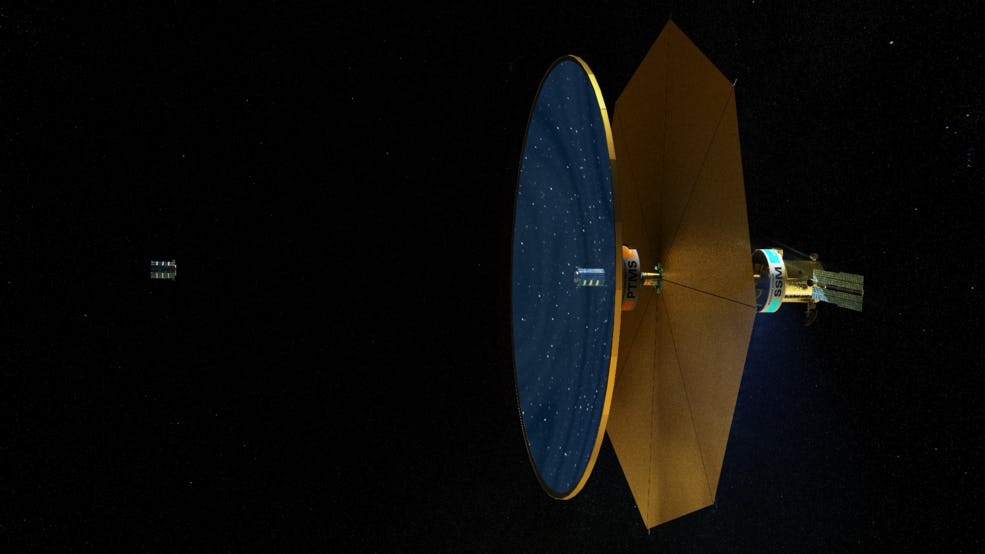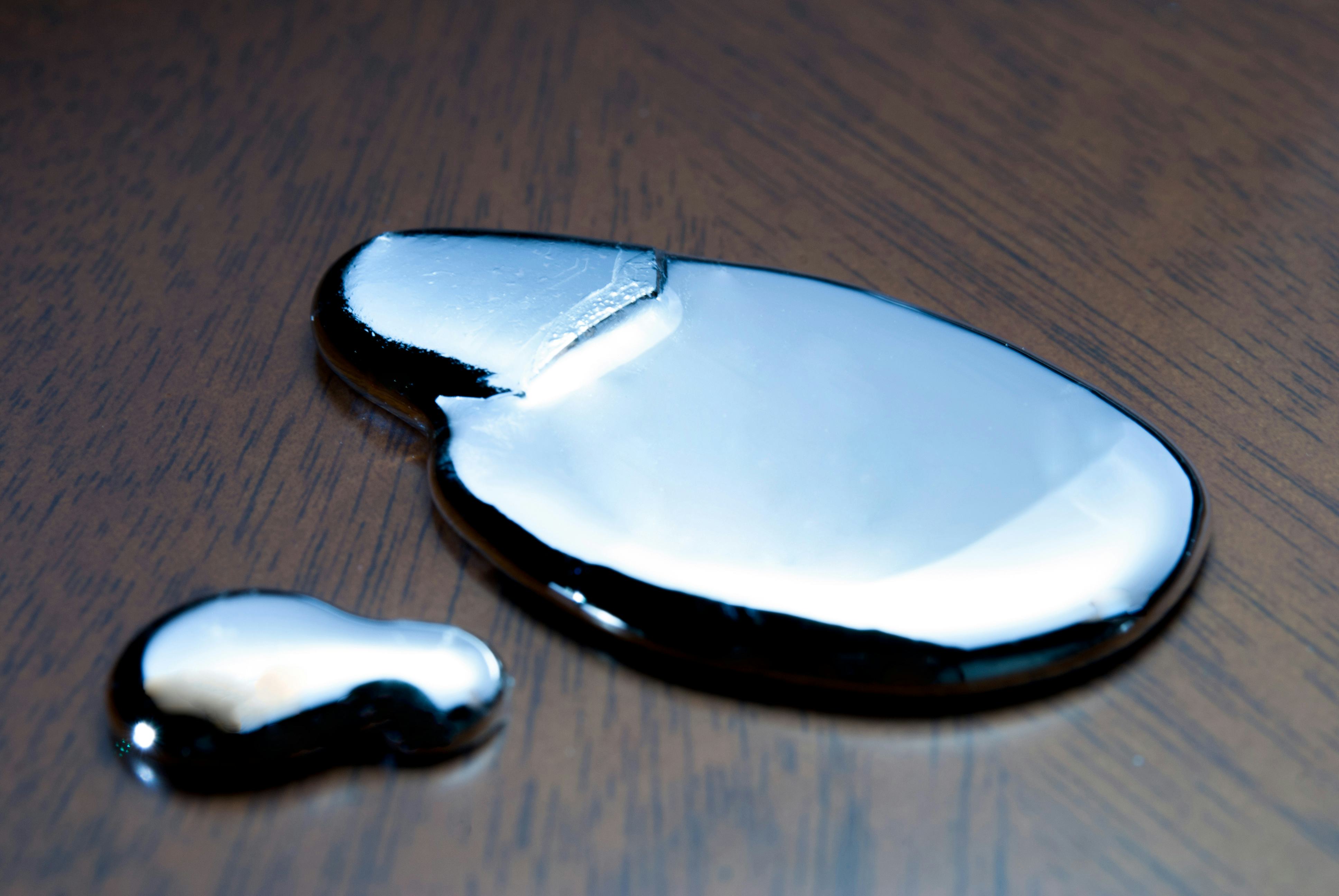
In May 2022, the James Webb Space Telescope (JWST) encountered a problem. The giant observatory, perched 1 million miles from Earth, has a honeycomb-like configuration of mirror panels to see the stars. But one of them was struck by a bigger-than-expected micrometeoroid. The agency reported in a blog post that it had “a marginally detectable effect in the data.” But a larger chunk of rock flying at unfathomable speeds could have delivered a bigger blow.
Its predecessor, Hubble, had experienced similar issues. A 1997 repair mission discovered that a micrometeroid had struck on the antenna of the space telescope, adding a new layer of difficulty to the shuttle crew’s maintenance of the observatory.
Strikes like these are a big hazard to some of the most expensive telescopes in the world. But maybe there's something that can be done. While Hubble was close enough to Earth for astronauts to service, JWST has no such luxury. But what if you could build a telescope that could repair itself?
Cosmic Backyards is an Inverse series that explores the cutting-edge research looking into the depths of the cosmos. This work is pushing the boundaries of our understanding of the universe, and our place in it.
Edward Balaban — a research scientst at NASA Ames — and his colleagues are exploring doing just that. But instead of creating a solid telescope mirror, they’re looking toward using liquid materials. Not only could it lead to space telescopes that can repair themselves, but it will also overcome several other hurdles of large telescopes including risky rocket flights and painstaking construction, and potentially be able to produce unfathomably large telescopes at the same time by manufacturing them in space. Called the Fluidic Telescope (FLUTE) project, the team suggests creating liquid mirrors 164 feet (50 meters) in diameter — nearly eight times the size of the mirror on JWST.
"If we are successful, we believe that large fluidic space telescopes will enable a real revolution in astronomy, allowing us to observe much fainter objects than currently possible and peer back further in time at the very early stars and galaxies," Balaban tells Inverse.
In turn, this could allow astronomers to look further back into the universe than ever, make out details of objects that appear as fuzzy points of light to even the most powerful telescopes right now, or even answer the question of if we’re alone in the universe by peering directly at alien worlds.
Drip Drip Drip
So why liquid?
The molecules in liquids can stick to one another more tightly than they do to other things, making the surfaces of those liquids act like flexible membranes that can be surprisingly strong. This property, known as surface tension, is the force that compels water droplets to bead up into the most compact shapes possible, and lets insects such as water striders walk on water without sinking.
On Earth, when droplets of water grows larger than roughly 0.09 inches (2 millimeters), gravity overcomes surface tension, squashing them flat. However, in space, even large amounts of liquid can, through surface tension, bead up into spheres. Liquids may stick to surfaces due to a property called adhesion. In microgravity (like you have in space), you could take advantage of adhesion to contain liquid materials in a circular frame. The liquid will stretch across the inside of the frame and naturally form a curved shape because of surface tension.
If a sufficient amount of liquid is made to adhere to the inner surface of a circular ring-like frame, By using the right volume of liquid, the surface of the liquid can curve inward instead of bulging outward. If the liquid is reflective, this inwardly curved surface can serve as a telescope mirror.
"I love innovations that push outside of the limits of how we currently implement missions," Morgan Cable, an astrochemist at NASA's Jet Propulsion Laboratory who is not part of Balaban’s team, tells Inverse. "Taking advantage of the fundamental properties of liquids such as surface tension to work to our advantage is a game-changing idea."
We’re Gonna Need a Bigger Telescope
Currently, JWST is the largest and most powerful space observatory ever built. It possesses a 21.3-foot-wide (6.5 meters) mirror dwarfing that of the Hubble Space Telescope more than twice over. The main mirror is 18 hexagonal segments built of gold-plated beryllium that create the huge light-gathering area of the telescope. It had to be folded like origami to fit in the nose cone of its rocket, and successfully deploying this mirror and the tennis-court-size sunshield designed to keep it cold was a project of unprecedented complexity.
The conventional way to make the optics for telescopes is literally a grind, involving repeatedly sanding and polishing solid materials such as glass or metal to create precisely curved and smooth lenses and mirrors. Using current technologies, the upper-limit of telescope size is around 33 feet (10 meters). scaling up space telescope optics to more than roughly 33 feet (10 meters) wide isn’t economically viable.
In theory, there is little limit to the size of liquid optics. "The same physics work whether a liquid optical component is 10 centimeters in diameter or 10 kilometers in diameter," Balaban says. This could make telescopes capable of feats we only dream of right now. For instance, planets outside our Solar System (exoplanets) appear right now to be, at best, specks of light — and that’s when we can see them directly, which isn’t very often. But Balaban says a large liquid telescope could take a look at surface features of nearby exoplanets. This could also give clues to if anything is alive there.
"Discovering any type of life outside of Earth would be immensely exciting," Balaban says. "It's a question that humans have pondered for millennia."

A Brief History of FLUTE
Balaban came up with the idea for this strategy after a conversation with an astronomer colleague about building telescopes even larger than JWST in space instead of launching them from Earth. Balaban’s colleague told him there is “no way” NASA or another agency would be able to construct telescopes in space with the kind of precision required with current technology. "That sort of got stuck in the back of my brain as a challenge," Balaban says.
A few months later, Balaban's long-time friend Moran Bercovici at the Technion – Israel Institute of Technology in Haifa came to visit him. Bercovici was working with microfluidics, but not for telescopes. Instead, it was for “lab-on-a-chip” technology where droplets of fluid get pushed around reconfigurable channels, allowing researchers to perform medical and chemistry research. "I then asked something along the lines of, 'What about using something like that to build a giant space telescope?'" Balaban says.
The two began collaborating on what would become FLUTE in 2020 just before the onset of the Covid-19 pandemic. By 2021, the FLUTE team flew several 1-inch test lenses on an airplane that can simulate microgravity. They followed that up in 2022 with a new design, twice the size and incorporating a gallium alloy. (Gallium is a metal with a very low melting point.) That same year, Israeli commercial astronaut Eytan Stibbe also created several 20-centimeter lenses on the International Space Station to test the tech in space.
Liquid Optics Come into Their Own
The underlying idea of FLUTE — using liquid metal to build telescope mirrors — has been around for decades. Until now, though, it’s hit a series of roadblocks. For instance, researchers explored spinning reflective liquids to create curved mirrors. This shape is necessary to funnel light to a sensor that can then build the image. The process works on Earth, but in the microgravity of space, the mirrors end up flat.
But FLUTE takes advantage of the way fluids naturally behave in microgravity. An eventual mission could thus fly the liquid metals as raw material, and the telescope’s optics could actually be constructed in orbit. According to David Leisawitz, an astrophysicist at NASA's Goddard Space Flight Center, who is not part of the research, this could help reduce both the size and mass of the launch, making it more fuel efficient while allowing for a larger space observatory.
"The liquid used to make the mirror can be very compact when the payload is launched, and it can be turned into a large mirror in space," Leisawitz tells Inverse.
An extra benefit that liquid optics have is how they can self-repair if damaged. Like the T-1000 in Terminator 2: Judgment Day, the telescope could heal itself. Hubble had to have astronauts repair it from time-to-time. JWST, which sits a million miles beyond Earth and has had its share of encounters with small dust and rocks striking the mirrors, has no such luxury. But a liquid optic telescope wouldn’t need this. The goal is to engineer the viscosity, thickness and other aspects of these optics so they can recover after "no more than several hours," Balaban says.
But scaling up the FLUTE project runs into the practical limitations of the size of how test experiments are flown. The plane they flew their experiments on is just a modified Boeing 727; the ISS is just about as cramped as a plane cabin. But an award from the NASA Innovative Advanced Concepts program granted in January will allow the FLUTE team to design, fund, and launch a small demo mission to low-Earth orbit. Rather than 25 or 50 millimeters, the team will assemble a 1-meter (3.28 foot) mirror aboard a small spacecraft that will also include instruments to analyze the quality of the resulting mirror, he notes.
Although the preliminary findings are promising "in order to be successful, this telescope would have to operate in space for a very long period of time," Cable says. "It will be important to understand how liquid-based lenses age in the conditions of space — vacuum, temperature cycling, radiation, and so on."
But astronomers like Cable are hopeful that it works, as it would open up entire new areas of astronomy.
"To me, the most exciting aspect of FLUTE is the sheer scale of it," Cable says. "When it comes to telescopes and their capabilities, everything depends on size. So this is a really big deal."







